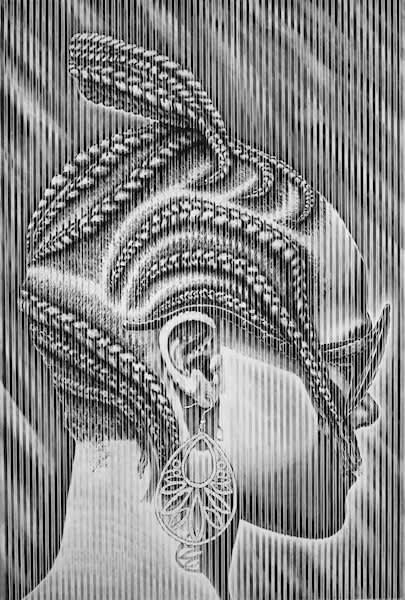From October 5 to 19, 2013, the Omenka Gallery will present Networks and Voids, Modern Interpretations of Nigerian Hairstyles and Headdresses, an exhibition of work by celebrated Nigerian photographer, ‘Okhai Ojeikere and one of the fast-rising names on the continent, American artist, Gary Stephens based in Johannesburg.
The works are presented in photography, linoleum prints and charcoal on paper, and are united by the central theme of Nigerian hairstyles and headdresses (geles) fashioned from hand-woven aso-oke and expensive imported textiles including damask, brocade and metallic-like jacquard. Both artists offer insight into Lagos society and successfully capture the creativity and opulence of social gatherings. The history of these fabrics is not only tied to the complex web of trade and negotiation between Africa and the West but is related to Nigeria’s socio-political development during the oil boom. Today, the outfits produced from these luxurious fabrics are an expression of prosperity.
The show draws its title from the patterns formed by the network of interlocking branches of finely plaited hair and voids left in their wake. These patterns are repeated in the weaves of the headdresses, where they give the impression of low relief embroidery and mimic matching lace outfits populated by open spaces. This notion of interconnectedness is further accentuated by the fact that though the artists are separated along racial lines, location and age, they are brought together through the investigation of these art forms.
Historian, Elisha P. Renne asserts that by referring to some of these textiles as laces, Nigerian consumers emphasize the open perforations, thus making reference to a range of textiles (embroidered, painted, or cut) and body art practices (tattooing, cutting, and painting) that utilize a similar combination of textured designs placed in open spaces.
In traditional African society, hairstyles had immense religious and cultural significance. During the slave trade, hairstyles played a major part in communicating age, marital status, ethnic identity, religion, wealth, and rank. Young Wolof girls of Senegal partially shaved their heads as an outward symbol they were not courting. Igbo wives, on losing their husbands shaved off all their hair in mourning.
The study of black American history reveals that the slave trade inflicted physical damage as well as deep emotional and psychological scars, the most devastating, still reflected today is that done to the image. This is especially true as it relates to hair and skin colour, as parameters for determining race. The slave owners often described African hair as “wooly” and likened them to animals. These and several other terms were used to justify the inhumane treatment meted out to slaves. After years of repression and witnessing those with “straight hair” and “light skin” afforded better opportunities, the slaves began to internalize these words.
Against this background, works by Ojeikere and Stephens become veritable sites to assert the African identity and challenge these stereotypes. The works then assume greater importance and new meanings along two major lines of thought; first when viewed against the preponderance of imported human and synthetic hair and skin-lightening beauty products, and second in documenting an ebbing culture. In modern times, the social significance and personal meaning of traditional hairstyles have been forgotten. Instead, ancient styles are re-born, with many variations linking them more with fashion.
At first glance, it seems rather disconcerting that the artists employ contemporary media and techniques to engage issues of preservation. Perhaps the similarities between the artists end here. In 1968, Ojeikere began to develop a series of photographs exploring Nigerian culture. The Hairstyles and Headdresses are his best-known and most significant bodies of work. Importantly, these series are shot in black-and-white and largely with an analogue camera, which lends to their cultural and historical significance. Time is at once frozen and the ephemeral nature of the hairstyles and headgears, which evolve with fashion trends is preserved.
Stephens is also successful in his fusion of the comparatively more traditional media of drawing and printmaking with meticulously crafted string systems. This dedication and striking attention to detail are clearly evident in his drawings. Combining long, vertical, repetitive folds and pleats in the paper with string systems, he emphasizes the three-dimensional quality of the weave patterns and voids in the plaited hair. These changing optical illusions are heightened when the drawings are viewed at several angles while moving across the picture plane. Here, the focus is slightly different. The system of strings and vertical pleats is a metaphor for the influence of modernity and the spread of global capitalism on post-colonial Nigeria. He raises questions of hybridity and identity as his subjects adorn sunglasses, modern earrings and decorative ornaments in their hair.
The works are strongly individual, their juxtapositioning providing a sense of urgency to an immediate purpose – to challenge the various stereotypes thrust on the African while addressing issues of personal identity, self-discovery and history.
